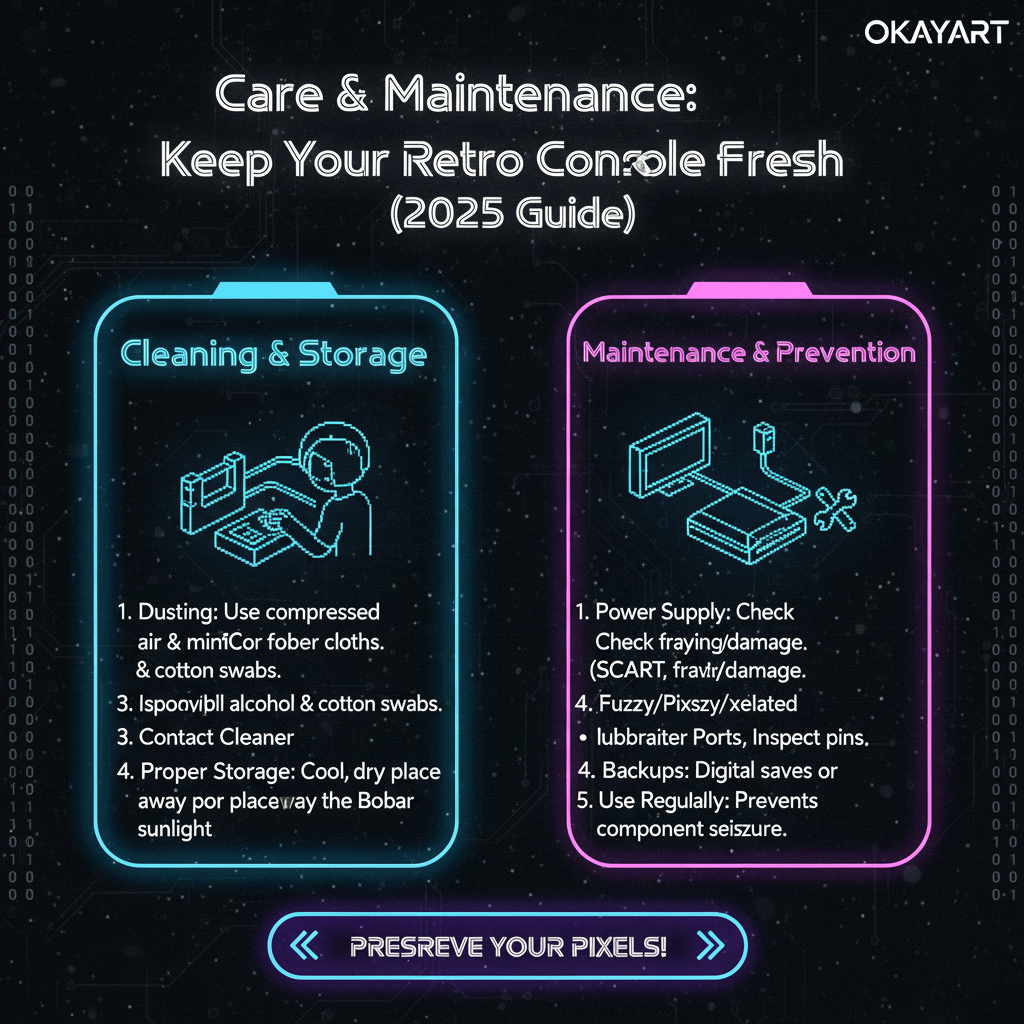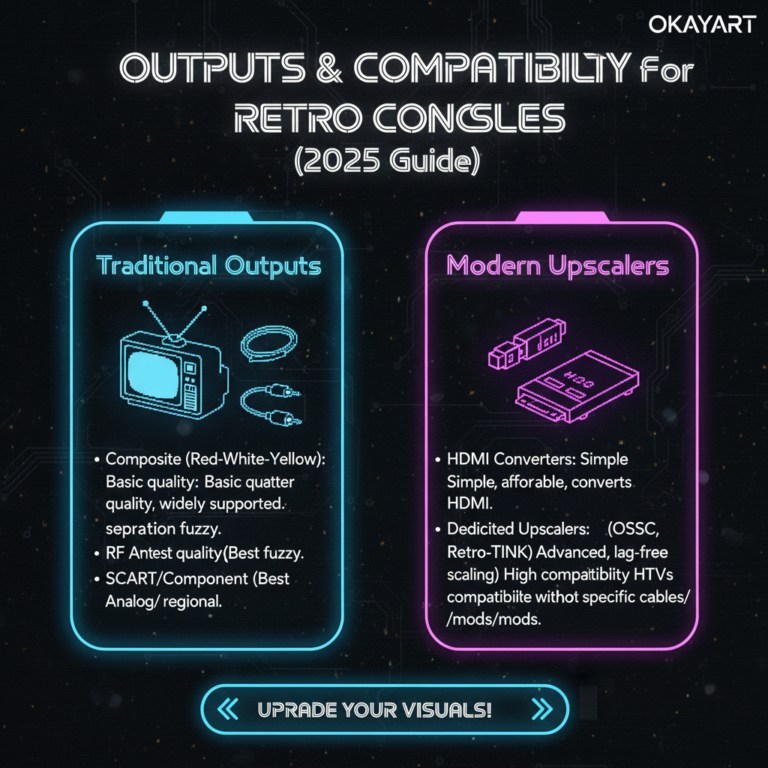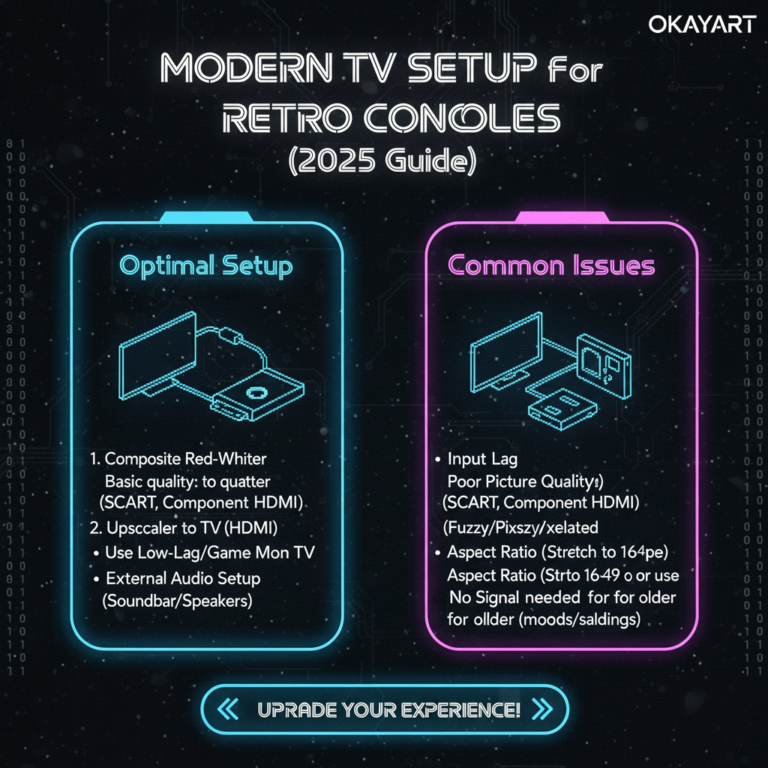Your cart is currently empty!
Care & Maintenance: Keep Your Retro Console Fresh
Brand‑new retro consoles deserve clean handling, safe power, and proper storage. This guide covers practical cleaning methods, what chemicals to avoid, how to store gear to prevent yellowing, and simple routines to keep picture and controls at their best. Built for US players (NTSC‑U) using real hardware—no ROMs/BIOS.
- Use 90%+ isopropyl alcohol and microfiber for contacts/shells; avoid harsh cleaners (bleach, acetone, ammonia).
- Store cool, dry, dark: about 18–24 °C (65–75 °F), 40–55% RH, away from UV; add silica gel.
- Power matters: match voltage & polarity, use a surge‑protected strip, and quality PSUs.
On this page: Shell & screen cleaning · Contacts & connectors · Controllers · Power safety · Storage & anti‑yellowing · Cables & coiling · Maintenance schedule · When to contact support · FAQ
Shell & Screen Cleaning (HELM)
Keep plastics and displays pristine with gentle, electronics‑safe methods. Always power down and unplug first, start dry, and spot‑test any liquid on an inconspicuous area before full use.
Do (safe)
- Dust first with a dry microfiber cloth.
- Spot‑clean with distilled water or 90%+ IPA on microfiber; use light pressure.
- Vents/crevices: soft brush or hand‑pumped blower; keep liquids away from openings.
- Screens: lens cloth, straight edge‑to‑edge passes; dry immediately.
Don’t (avoid)
- No acetone, ammonia, bleach, or abrasive powders—these can etch plastics/coatings.
- Don’t soak seams/ports; avoid drips and puddles.
- Don’t use close‑range high‑pressure canned air (risk of propellant frost marks).
Method (step‑by‑step)
- Power off & unplug. Remove media; let the device cool.
- Dry dust. Wipe shell and screen with a clean microfiber to lift loose particles.
- Spot clean. Dampen microfiber with distilled water; for hard plastics (not coated displays), a few drops of 90%+ IPA. Wipe in straight lines.
- Detail. Soft brush/blower for vents and seams; never flood liquid into openings.
- Screen finish. Lens cloth only; if needed, a 1:1 distilled water:IPA mix on the cloth (not the screen), then dry at once.
- Final check. Ensure surfaces are dry and strain relief on cables is OK before powering on.
Materials checklist
- Microfiber cloths (separate for shell and screen)
- Distilled water; 90%+ isopropyl alcohol (IPA)
- Soft detailing brush; hand‑pumped blower
- Lens cloth for displays
Contacts & Connectors (clean picture, reliable reads)
- Cartridge contacts: microfiber or lint‑free swab + 90%+ IPA; gentle straight strokes; let dry fully.
- Ports (HDMI/AV/RGB): blow out dust; for oxidation use a tiny amount of contact cleaner (e.g., DeoxIT D5) on a swab, then dry. Avoid WD‑40‑type products.
- SCART/Component: use reputable, shielded cables; verify pinout; seat firmly to reduce noise.
Controllers (sticks, buttons, membranes)
- Exterior: microfiber with a little IPA; dry thoroughly.
- Sticky buttons: minimal IPA around the cap edge while pressing, then dry. For deep cleaning, refer to the model‑specific guide.
- Stick drift: clean first; if no improvement, contact support or replace the module (avoid breaking warranty seals).
Power Safety (protect your hardware)
- Match voltage & polarity (check the PSU label). US mains: 120 V / 60 Hz.
- Use a surge‑protected power strip; avoid daisy‑chaining cheap adapters.
- If your PSU is 220–240 V only, use a proper step‑down transformer (adequate wattage).
- Unplug during lightning storms or long storage.
Storage & Anti‑Yellowing
- Environment: cool, dry, dark—~18–24 °C (65–75 °F), 40–55% RH.
- UV control: avoid direct sunlight; use UV‑blocking bins/bags if exposed.
- Desiccants: add silica gel packets; replace when saturated.
- Cable relief: coil loosely; avoid tight bends and weight on connectors.
- Yellowing note: mainly UV + brominated ABS aging. We don’t recommend chemical “retrobright” on brand‑new shells—risk > reward.
Cables & Coiling
- Use short, shielded analog cables; for HDMI use certified 6–10 ft runs.
- Use the over‑under coil method to reduce twist and stress; prefer Velcro straps over rigid ties.
- Label cables (HDMI‑1 “Retro”, Component “PS2”) for quick setup.
Maintenance Schedule (print‑friendly)
| Interval | Task | Notes |
|---|---|---|
| Every session | Wipe screen/shell; tidy cables; Game Mode on | Prevent buildup and lag |
| Monthly | Dust vents; clean controllers; check contacts | Use blower/IPA + microfiber |
| Quarterly | Inspect cables/ports; test spare PSU; back up saves | Replace failing cords; confirm polarity |
| Before storage | Power off/unplug; bag in dry, dark bin with silica | Label contents; avoid tight coils |
When to Contact Support (don’t risk damage)
- Burning smell, unusual heat, or bulging capacitors.
- Persistent “no signal” across multiple cables/ports/adapters.
- Intermittent power even with a known‑good PSU.
- Visible cracks or liquid ingress.
Need help? Email support@okayartgames.com or use the contact form. We usually reply within 24–48 h (Mon–Fri).
FAQ
Q: Is 70% alcohol OK?
Use 90%+ isopropyl alcohol for electronics; lower concentrations dry slower and may leave residue.
Q: Can I use compressed air?
Yes, but use short bursts at a distance and keep the can upright to avoid propellant spray.
Q: How do I prevent yellowing?
Avoid UV, control temperature/humidity, and store in UV‑blocking bins; we don’t recommend chemical whitening for new plastics.
Related guides
- Modern TV setup for retro consoles
- Outputs & upscalers guide
- Quick fixes: no signal / color / sound
- Region & compatibility (NTSC‑U vs PAL)
Warranty note: Opening the console, liquid exposure, or unapproved mods can void coverage. When in doubt, contact support first.



